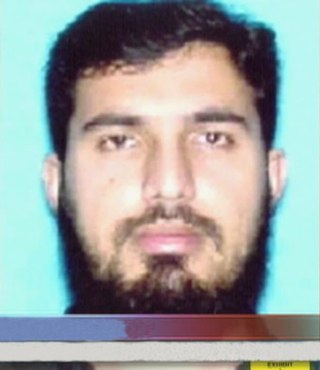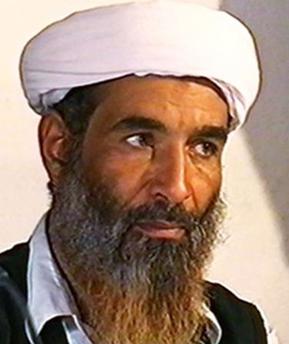Related Research Articles

Al-Qaeda is a Sunni pan-Islamist militant organization led by Salafi jihadists who self-identify as a vanguard spearheading a global Islamist revolution to unite the Muslim world under a supra-national Islamic state known as the Caliphate. Its members are mostly composed of Arabs, but also include other peoples. Al-Qaeda has mounted attacks on civilian and military targets in various countries, including the 1998 United States embassy bombings, the 2001 September 11 attacks, and the 2002 Bali bombings; it has been designated as a terrorist group by the United Nations Security Council, the North Atlantic Treaty Organization (NATO), the European Union, and various countries around the world.
Ibn al-Shaykh al-Libi was a Libyan national captured in Afghanistan in November 2001 after the fall of the Taliban; he was interrogated by American and Egyptian forces. The information he gave under torture to Egyptian authorities was cited by the George W. Bush Administration in the months preceding its 2003 invasion of Iraq as evidence of a connection between Saddam Hussein and al-Qaeda. That information was frequently repeated by members of the Bush Administration, although reports from both the Central Intelligence Agency (CIA) and the Defense Intelligence Agency (DIA) strongly questioned its credibility, suggesting that al-Libi was "intentionally misleading" interrogators.
Wadih Elias el-Hage is Lebanese, and naturalized American citizen, who is serving life imprisonment in the United States based on conspiracy charges for the 1998 United States embassy bombings. Born to a Maronite Catholic family, El-Hage converted to Islam while still in Lebanon in the 1970s. He emigrated to the United States, where he developed an interest in militant interpretations of Islamic theology while attending the University of Louisiana at Lafayette.
The Maktab al-Khidamat, also Maktab Khadamāt al-Mujāhidīn al-'Arab, also known as the Afghan Services Bureau, was founded in 1984 by Abdullah Azzam, Wa'el Hamza Julaidan, Osama bin Laden and Ayman al-Zawahiri to raise funds and recruit foreign mujahideen for the war against the Soviets in Afghanistan. MAK became the forerunner to al-Qaeda and was instrumental in creating the fundraising and recruitment network that benefited Al-Qaeda during the 1990s.

Abdullah Yusuf Azzam was a Salafi jihadist, a Palestinian scholar, and theologian of Sunni Islam. During the Soviet–Afghan War of the 1980s, he advocated "defensive jihad" by Muslims worldwide to help the Afghan mujahideen fight against Soviet forces in the Democratic Republic of Afghanistan.
On September 11, 2001, 19 al-Qaeda terrorists took control of four commercial aircraft and used them as suicide weapons in a series of four coordinated acts of terrorism to strike the World Trade Center in New York City, The Pentagon in Arlington County, Virginia, and an additional target in Washington, D.C. Two aircraft hit the World Trade Center while the third hit the Pentagon. A fourth plane did not arrive at its target, but crashed into a field in Pennsylvania after a passenger revolt. The intended target is believed to have been the United States Capitol. As a result, 2,977 victims were killed, making it the deadliest foreign attack on U.S. soil, exceeding Japan's surprise attack on Pearl Harbor in Honolulu, Hawaii, on December 7, 1941, which killed 2,335 members of the United States Armed Forces and 68 civilians. The effort was carefully planned by al-Qaeda, which sent 19 terrorists to take over Boeing 757 and Boeing 767 aircraft, operated by American Airlines and United Airlines.

Mahmud Abouhalima is an Egyptian citizen who is convicted as perpetrator of the 1993 World Trade Center bombing. He is currently serving a 67-year sentence at ADX Florence in Florence, Colorado for his role in the bombing.

The Quds Force is one of five branches of Iran's Islamic Revolutionary Guard Corps (IRGC) specializing in unconventional warfare and military intelligence operations. U.S. Army's Iraq War General Stanley McChrystal describes the Quds Force as an organization analogous to a combination of the CIA and the Joint Special Operations Command (JSOC) in the United States. Responsible for extraterritorial operations, the Quds Force supports non-state actors in many countries, including Hezbollah, Hamas, Palestinian Islamic Jihad, Yemeni Houthis, and Shia militias in Iraq, Syria, and Afghanistan.
Ali Abdul Saoud Mohamed is a double agent who worked for both the U.S. Central Intelligence Agency and Egyptian Islamic Jihad simultaneously, reporting on the workings of each for the benefit of the other.

Islam is a minority religion in Finland. The first Muslims were Tatars who immigrated mainly between 1870 and 1920. After that there were decades with generally a small number of immigration in Finland. Since the late 20th century the number of Muslims in Finland has increased rapidly due to immigration. Nowadays, there are dozens of Islamic communities in Finland, but only a minority of Muslims have joined them. Projecting from 2010 data, Pew Research Center estimated that in 2016 about 2.7% of Finland's 5.5 million population was Muslim. In the high migration scenario, Finland's Muslim population could grow to 15% by 2050 which would equal almost a million Muslims in Finland.
Mustafa Shalabi was a founder of several charities alleged to have links to terrorism who was found murdered on February 25, 1991.

Abu al-Walid was a Saudi Arabian of the Ghamd tribe who fought as a "mujahid" volunteer in Central Asia, the Balkans, and the North Caucasus. He was killed in April 2004 in Chechnya by the Russian federal forces.
Evan F. Kohlmann is an American terrorism consultant who has worked for the FBI and other governmental organizations.

After the Central Intelligence Agency lost its role as the coordinator of the entire Intelligence Community (IC), special coordinating structures were created by each president to fit his administrative style and the perceived level of threat from terrorists during his term.
An Egyptian resident of British Columbia, Essam Hafez Mohammed Marzouk arrived in Vancouver, British Columbia, Canada in 1993 as a refugee fleeing persecution in Pakistan. He was one of 14 people subjected to extraordinary rendition by the CIA prior to the 2001 declaration of a war on terror.

The international activities of Al-Qaeda includes involvements in Europe, where members of the group have been involved in militant and terrorist activities in several countries. Al-Qaeda has been responsible for or involved in attacks in Western Europe and Russia, including the 2004 Madrid train bombings, 2010 Moscow Metro bombings, 2011 Domodedovo International Airport bombing, and the January 2015 Île-de-France attacks.

Najibullah Zazi is an Afghan-American who was arrested in September 2009 as part of the 2009 U.S. al Qaeda group accused of planning suicide bombings on the New York City Subway system, and who pleaded guilty as have two other defendants. U.S. prosecutors said Saleh al-Somali, al-Qaeda's head of external operations, and Rashid Rauf, an al-Qaeda operative, ordered the attack. Both were later killed in drone attacks.

Mohammed Atef was the military chief of al-Qaeda, and was considered one of Osama bin Laden's two deputies, the other being Ayman Al Zawahiri, although Atef's role in the organization was not well known by intelligence agencies for years. He was killed in a US airstrike in November 2001.
Following the embargo by Arab oil exporters during the Israeli-Arab October 1973 War and the vast increase in petroleum export revenue that followed, the international propagation of Salafism and Wahhabism within Sunni Islam favored by the conservative oil-exporting Kingdom of Saudi Arabia and other Gulf monarchies achieved a "preeminent position of strength in the global expression of Islam." The Saudi interpretation of Islam not only includes Salafiyya but also Islamist/revivalist Islam, and a "hybrid" of the two interpretations.
References
- ↑ Al Kifah Refugee Center, Tracking the threat Archived May 6, 2006, at the Wayback Machine
- 1 2 3 Complete 911 Timeline, Cooperative Research Archived April 27, 2006, at the Wayback Machine
- ↑ Asthana, N.C. and A. Nirmal. Urban Terrorism : Myths And Realities. Pointer Publishers, 2009. 109 Archived May 30, 2016, at the Wayback Machine . Retrieved from Google Books on February 17, 2011. "[...] the hub of which was the Al Kifah Refugee Center at the Farooq Mosque in Brook7klyn's[ sic ] Atlantic Avenue." ISBN 81-7132-598-X, 9788171325986.
- ↑ Kohlmann, Evan. Al-Qaida's Jihad in Europe: the Afghan-Bosnian Network. Berg Publishers, 2004. ["[...] Al-Kifa Refugee Center, 552 Atlantic Avenue, Brooklyn NY." 50]. Retrieved from Google Books on February 17, 2011. "[...] Al-Kifa Refugee Center, 552 Atlantic Avenue, Brooklyn NY." ISBN 1-85973-807-9, ISBN 978-1-85973-807-8.
- ↑ Tangled Ties: Law-enforcement officials follow the money trail among suspected terrorists straight to the doors of the Saudi Embassy Archived August 20, 2007, at the Wayback Machine , Newsweek , April 7, 2003
- ↑ Stockman, Farah. Activist turned extremist, US says. Archived September 4, 2014, at the Wayback Machine The Boston Globe. August 12, 2008.